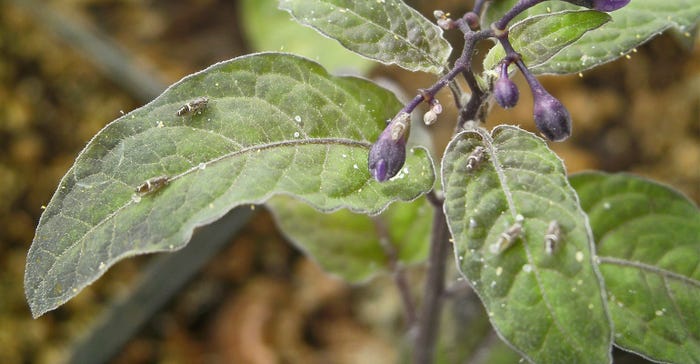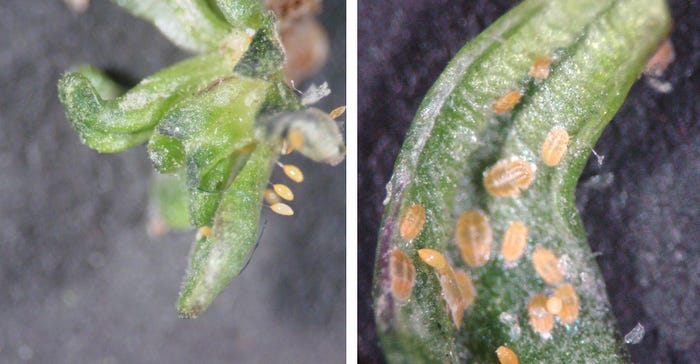March 2, 2017

Editor’s note: This is the 12th story in a series exploring the opportunities and issues of potato growers across the region.
When it comes to potato psyllids and the diseases they vector — notably zebra chip — Pacific Northwest growers are facing yet another opponent in the ring, which is making control efforts much more difficult.
In most growing areas west of the Mississippi River, where ZC occurs, farmers typically only have to deal with one genetic type.
But researchers have recently discovered that the potato psyllid population in the PNW growing region is actually a mixture of three genetic types (or “haplotypes”).
“We are finding that the haplotypes differ in biology and, therefore, potentially in how they should each be managed by growers,” says David Horton, research entomologist for the USDA Agricultural Research Service in Wapato, Wash.
In the southern growing regions, producers typically apply insecticides as soon as potatoes emerge, because the psyllid is around and active at that time.
In the PNW, however, it’s a different story.
Horton says that one haplotype is entirely resident and able to overwinter in very cold temperatures on the perennial weed bittersweet nightshade (Solanum dulcamara), and possibly matrimony vine (Lycium species). The other two haplotypes, meanwhile, arrive in PNW potato fields in late spring or early summer, either as migrants from southern growing regions or possibly as a mixture of migrants and locally overwintered insects.
“The primary complication due to not knowing the source of each of these haplotypes is that it is very difficult for growers to know when, and in what potato fields, the psyllid is likely to first arrive,” Horton says.
For example, he notes, if the psyllids first to arrive in potato fields are those that overwinter in the region, this might suggest that fields close to overwintering sites (say, patches of bittersweet nightshade) might be first to be colonized.
If, however, the psyllids are arriving as migrants from southern regions, it would be very difficult to predict when and where the psyllid will arrive in the PNW. Scientists are trying to get a handle on this with a major research project now underway.
“As you move north from the most southern growing regions, the timing issue of insecticide application becomes increasingly complicated, given disconnect between phenology of crop emergence and phenology of psyllid arrival,” Horton says. “My understanding is that this uncertainty has led to some reliance on calendar-based applications of insecticides as a precaution against ZC, which is a substantial departure from pre-psyllid integrated pest management programs.”
Adding to the uncertainty, Horton continues, is the fact that there is some reproductive incompatibility between haplotypes; thus, mating of males and females of unlike genetic makeup leads to non-fertile eggs in some circumstances.
“We do not yet know what this means for the grower, but it is another indication of biological differences among haplotypes,” he says.
Words of wisdom
Does Horton have any words of wisdom for PNW growers?
“Continue making use of the large monitoring programs for potato psyllids currently in place by the University of Idaho, Oregon State University and Washington State University. And, if you happen to have a field close to large stands of bittersweet nightshade, definitely be aware that this particular field may be at risk of psyllid infestation.”
It’s likely that other plants play hosts to psyllids as well, since the critters are being found on matrimony vine and field bindweed, aka morningglory (Convolvulus arvensis).
“That’s not a good thing,” says Erik Wenninger, University of Idaho associate professor of entomology.
Wenninger and Horton suggest that growers continue to work closely with neighbors, weed and pest control districts, Extension educators and others to monitor for psyllids not only in their potato fields, but also weed patches as well.
And consider weed control part of an effective integrated pest management program.

ARDUOUS TASK: Washington State University postdoctoral research associate Daisy (Zhen) Fu uses a suction sampler to collect psyllids from matrimony vine. (Photo courtesy of Bill Snyder, Washington State University)

Is it time to divorce matrimony vine?
Bill Snyder, Washington State University professor of entomology, and a team of researchers are trying to figure out a complicated puzzle. If they do, it could potentially save potato growers in the Pacific Northwest — and possibly beyond — millions of dollars.
“We know there are potato psyllids in our region. And we know there are weeds that those insects live on year-round. But there are some missing links," Snyder says.
• Are the potato psyllids that are living on bittersweet nightshade (Solanum dulcamara) the same psyllids that go into your potato fields?
• What about the psyllids being found on matrimony vine (Lycium spp.) and morningglory (Convolvulus arvensis)? Are they related to either or both of the psyllid populations mentioned above?
• Are these psyllids unique to the PNW, or are they related to populations of psyllids that move into the area from elsewhere?
• And, most importantly, which populations carry the zebra chip bacterium?
These are among the questions that Snyder and associates are trying to answer. The group has received nearly $2.7 million in USDA funding to discover better ways to manage the potentially deadly disease zebra chip, as well as the critter that acts as a vector — the potato psyllid.

ON THE RADAR: Since potato psyllids are being found on bittersweet nightshade (pictured) and matrimony vine, producers are encouraged to control both of these weeds. (Photo courtesy of Bill Snyder, Washington State University)

Unfortunately, Snyder says, preliminary findings are pointing to a potentially very complex situation.
“What we’re seeing already is that a subset of the insects that are being found in potato fields are very, very closely related to the insects that we’re finding on bittersweet nightshade,” he says, in reference to the perennial weed that’s in the same family as the potato.
“But we’re also finding some insects in potato fields that don’t seem to be at all related to the insects that are on bittersweet nightshade,” Snyder says. “So that gives us some indirect evidence that there must be some other host plant, or something else that’s going on.”
The Snyder team is now investigating whether matrimony vine is playing host to a distinct population of psyllids.
Time to divorce?
In the late 1800s, some homesteaders planted matrimony vine following their weddings because it was believed that consuming goji berries from the introduced plant would lead to a long, healthy life.
“The potato psyllid also seems to like this same plant, and it’s possible that matrimony vine could be supplying the other population of psyllids,” Snyder says.
Matrimony vine, like bittersweet nightshade, has been a pretty obscure plant to most everyone except plant nerds. That’s no longer the case for nightshade, and growers — along with weed control districts and others — may be told to start divorce proceedings with matrimony vine if it’s indeed a host plant to the psyllid.
Scientists trying to unravel the mystery now know that some psyllids overwinter in the Pacific Northwest, but other psyllids move in from the outside, perhaps with the help of weather fronts.
“These are all potato psyllids, but we’re trying to figure out how genetically different they are from one part of the country to another. We believe they will all be pretty closely related. But since some populations don’t breed with other populations, and since populations are isolated from each other, are they genetically different?”
Those are among the questions Snyder and company are trying to answer.
Joining him in this five-year study are Washington State University scientists; entomologists at the USDA research laboratory in Yakima, Wash.; an agricultural economist from The College of Idaho; Extension scientists from Idaho, Oregon and Washington; and the Northwest Potato Research Consortium.
“Since this is a regional problem, this project offers a great opportunity for all of us to work really, really closely together,” Snyder says.

UNWELCOME HOST: The matrimony vine, planted for good luck and health in the past, may not be such good news since it could be a overwintering home to one breed of potato psyllid. On the left on matrimony vine are psyllid eggs; on the right are psyllid nymphs. (Photos courtesy of David Horton, USDA ARS)

All eyes on psyllids
Snyder says that potato farmers in the region are getting a handle on psyllids with extensive control programs, but these efforts are taking incredible time and expense.
On top of this, he says, psyllids and the potentially deadly disease they transmit, zebra chip, are currently driving most of the spray decisions, but these decisions are based on a lot of unknowns and uncertainty.
“When you have the situation we have right now — where growers have no ability to predict whether they’re likely to have a problem in their fields — they’re having to spray preventatively, and that is much more expensive than if you had solid information to go by,” Snyder says.
He offers the following scenario with a typical grower's thinking as an example: “‘OK, there is no zebra chip in my area right now, so I don’t have to spray. But with information I have at hand, I know that it’s very likely there will be psyllids in the area in two weeks — so I can plan my spraying accordingly,’" he says." Those targeted sprays could save growers a lot of money.”
Snyder and a team of researchers in Washington, Oregon and Idaho are trying to figure out travel patterns of psyllids and which populations carry ZC. Once they get a good handle on this, they plan to begin creating predictive, mobile-friendly maps that farmers can use to gauge risks and plan control programs accordingly.
“If we can predict in advance where the psyllids are going to be and when they’re going to be there, that will give growers good information on when they need to time their sprays to be most effective — or when they could skip some sprays and not worry about their fields being at risk,” he says.
Though the project is in its infancy, data from sampling that will take place in Idaho, Oregon and Washington will be funneled to Washington State University, where important information will be posted at potatoes.wsu.edu.
About the Author(s)
You May Also Like




